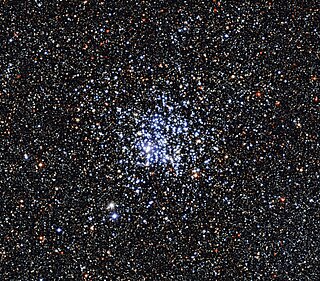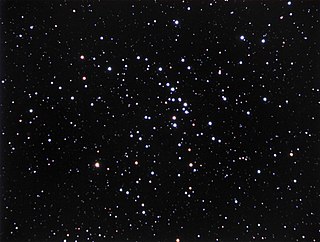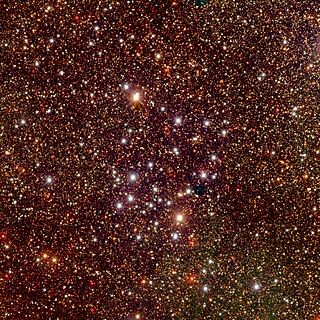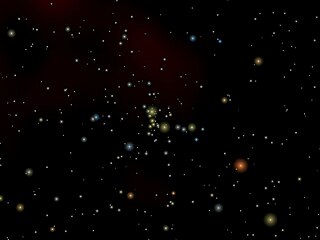
Hydra is the largest of the 88 modern constellations, measuring 1303 square degrees, and also the longest at over 100 degrees. Its southern end borders Libra and Centaurus and its northern end borders Cancer. It was included among the 48 constellations listed by the 2nd century astronomer Ptolemy. Commonly represented as a water snake, it straddles the celestial equator.

Messier 7 or M7, also designated NGC 6475 and sometimes known as the Ptolemy Cluster, is an open cluster of stars in the constellation of Scorpius. The cluster is easily detectable with the naked eye, close to the "stinger" of Scorpius. With a declination of −34.8°, it is the southernmost Messier object.

The Wild Duck Cluster is an open cluster of stars in the constellation Scutum. It was discovered by Gottfried Kirch in 1681. Charles Messier included it in his catalogue of diffuse objects in 1764. Its popular name derives from the brighter stars forming a triangle which could resemble a flying flock of ducks. The cluster is located just to the east of the Scutum Star Cloud midpoint.

Messier 48 or M48, also known as NGC 2548, is an open cluster of stars in the equatorial constellation of Hydra. It sits near Hydra's westernmost limit with Monoceros, about 18° 34′ to the east and slightly south of Hydra's brightest star, Alphard. This grouping was discovered by Charles Messier in 1771, but there is no cluster precisely where Messier indicated; he made an error, as he did with M47. The value that he gave for the right ascension matches, however, his declination is off by five degrees. Credit for discovery is sometimes given instead to Caroline Herschel in 1783. Her nephew John Herschel described it as, "a superb cluster which fills the whole field; stars of 9th and 10th to the 13th magnitude – and none below, but the whole ground of the sky on which it stands is singularly dotted over with infinitely minute points".

Messier 93 or M93, also known as NGC 2447 or the Critter Cluster, is an open cluster in the modestly southern constellation Puppis, the imagined poop deck of the legendary Argo.

NGC 381 is an open cluster of stars in the northern constellation of Cassiopeia, located at a distance of approximately 3,120 light-years from the Sun. Credit for the discovery of this cluster was given to Caroline Herschel by her brother William in 1787, although she may never have actually seen it.

NGC 2204 is an open cluster of stars in the Canis Major constellation. It was discovered by the German-English astronomer William Herschel on 6 February 1785. The cluster has an integrated visual magnitude of 8.6 and spans a diameter of 10.0′. Resolving the individual member stars is a challenge with a 10 to 12-inch amateur telescope. It is located at a distance of approximately 13,400 light years from the Sun. The cluster shows a mean radial velocity of +91.38±0.30 km/s relative to the Sun, and is orbiting the inner galactic disk region about 1 kpc below the galactic plane.

NGC 2546 is a pair of independent but overlapping open clusters located in the southern constellation of Puppis. This grouping was discovered by French astronomer Abbe Lacaille in 1751-1752 from South Africa. NGC 2546 is just visible to the naked eye as a fuzzy patch; the brightest component has an apparent visual magnitude of 6.44. The brighter members are readily resolved with a pair of 10×50 binoculars.

NGC 2022 is a planetary nebula in the equatorial constellation of Orion, located at a distance of 8.21 kilolight-years from the Sun. It was first observed by William Herschel on December 28, 1785, who described it as: considerably bright, nearly round, like a star with a large diameter, like an ill-defined planetary nebula. In medium-sized amateur telescopes it looks like a small grayish patch of light. It is not very bright but it is still easy to spot it in the eyepiece. Even in a telescope as small as 80mm it can just be seen using a narrowband filter such as an OIII filter as a 'fuzzy' star. The object has the shape of a prolate spheroid with a major to minor axis ratio of 1.2, an apparent size of 28″, and a halo extending out to 40″, which is about the angular diameter of Jupiter as seen from Earth.

NGC 6709 is an open cluster of stars in the equatorial constellation of Aquila, some 5° to the southwest of the star Zeta Aquilae. It is situated toward the center of the galaxy at a distance of 3,510 light-years.

NGC 2374 is an open cluster of stars in the Canis Major constellation. It was discovered on January 31, 1785 by the German-British astronomer William Herschel. This cluster is relatively rich in stars but is scattered across an angular diameter of 19.0′. It has an integrated visual magnitude of 8.0 and can be viewed with a modest amateur telescope. NGC 2374 is located at a distance of approximately 3,950 light-years (1,212 pc) from the Sun.

NGC 637 is an open cluster of stars in the northern constellation of Cassiopeia, positioned about 1.5° to the WNW of the star Epsilon Cassiopeiae. The cluster was discovered on 9 November 1787 by German-born English astronomer William Herschel. It is located in the Perseus Arm of the Milky Way, at a distance of approximately 7.045 kilolight-years from the Sun. The cluster is small but compact, and is readily visible in a small telescope.

NGC 6834 is a young open cluster of stars located about 10,850 light years from the Sun in the constellation Cygnus. It was discovered on July 17, 1784, by Anglo-German astronomer William Herschel. The cluster has a visual magnitude of 7.8, which is dimmed by 2.1 magnitudes due to interstellar dust. Half the cluster members lie within an angular radius of 6′.

NGC 6281 is an open cluster of stars in the constellation Scorpius. It was not included in the Messier or Caldwell catalogues of nebulous objects, but it is the brightest such cluster in the constellation to be left out of both. It is readily observed with the naked eye; it is located about 2° to the east of Mu Scorpii. James Dunlop described the cluster as a "curiously curved line of pretty bright stars, with many stars mixt". John Herschel then described the cluster as both "pretty bright" and "pretty rich".

NGC 146 is a small open cluster in the constellation Cassiopeia. It was discovered by John Herschel in 1829 using his father's 18.7 inch reflecting telescope.

NGC 7209 is an open cluster in the constellation Lacerta. It was discovered by William Herschel on 19 October 1787. The cluster lies 3,810 light years away from Earth. It has been suggested that there is another cluster at a distance of 2,100 light years projected in front of a cluster lying at 3,800 light years away, based on the reddening of the cluster, however, further photometric studies of the cluster did not support that claim.

NGC 2266 is an open cluster of stars in the constellation of Gemini. It was discovered by German-British astronomer William Herschel on 7 December 1785. This is a relatively dim cluster with an integrated visual magnitude of 9.5 and an angular size of 5.0′. The stellar members can be readily resolved with an amateur telescope. NGC 2266 is located at a distance of 10,603 ly (3,251.0 pc) from the Sun. It is located close to the opposite part of the sky from the Galactic Center, or the anti-center.

NGC 7160 is an open cluster in the constellation Cepheus. It was discovered by William Herschel on November 9, 1789. The cluster was also observed by John Herschel on October 7, 1829. It is a poor cluster and with little central concentration, with Trumpler class II3p. It is part of the stellar association Cepheus OB2, located one degree south-southwest of VV Cephei.

NGC 6910 is an open cluster in the constellation Cygnus. It was discovered by William Herschel on October 17, 1786. The cluster was also observed by John Herschel on September 18, 1828. It is a poor cluster with prominent central concentration and Trumpler class I2p. NGC 6910 is the core cluster of the stellar association Cygnus OB9.

NGC 1513 is an open cluster of stars in the northern constellation of Perseus, positioned 2° SSE of the faint star Lambda Persei. The same telescope field contains the clusters NGC 1528 and NGC 1545. NGC 1513 was discovered in 1790 by the German-British astronomer William Herschel. The brightest component star is of magnitude 11, so a medium-sized amateur telescope is needed to observe 20-30 members. With a 12 in (30 cm) aperture telescope, most of the member stars can be resolved. This cluster is located at a distance of 4,824 light-years from the Sun, but is drawing closer with a radial velocity of −14.7 km/s.




















